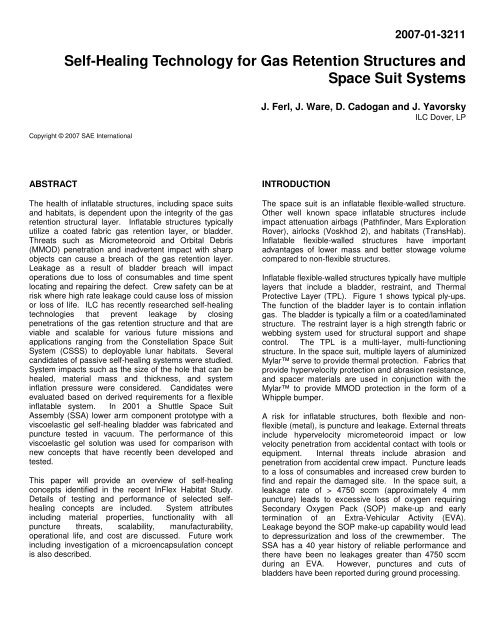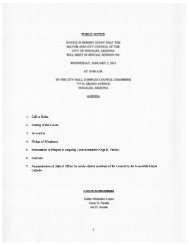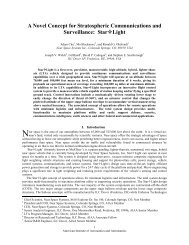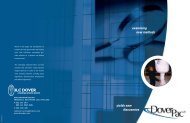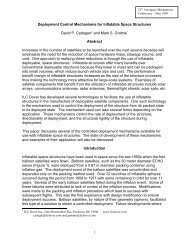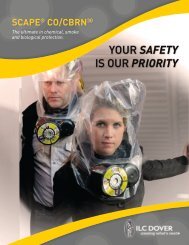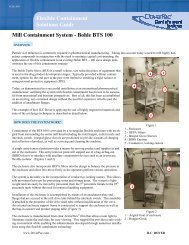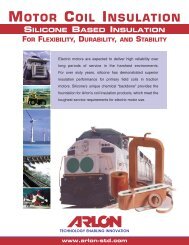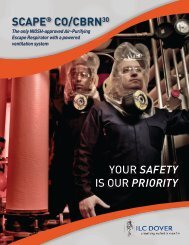Self-Healing Technology for Gas Retention Structures ... - Team-Logic
Self-Healing Technology for Gas Retention Structures ... - Team-Logic
Self-Healing Technology for Gas Retention Structures ... - Team-Logic
- No tags were found...
You also want an ePaper? Increase the reach of your titles
YUMPU automatically turns print PDFs into web optimized ePapers that Google loves.
2007-01-3211<strong>Self</strong>-<strong>Healing</strong> <strong>Technology</strong> <strong>for</strong> <strong>Gas</strong> <strong>Retention</strong> <strong>Structures</strong> andSpace Suit SystemsCopyright © 2007 SAE InternationalJ. Ferl, J. Ware, D. Cadogan and J. YavorskyILC Dover, LPABSTRACTThe health of inflatable structures, including space suitsand habitats, is dependent upon the integrity of the gasretention structural layer. Inflatable structures typicallyutilize a coated fabric gas retention layer, or bladder.Threats such as Micrometeoroid and Orbital Debris(MMOD) penetration and inadvertent impact with sharpobjects can cause a breach of the gas retention layer.Leakage as a result of bladder breach will impactoperations due to loss of consumables and time spentlocating and repairing the defect. Crew safety can be atrisk where high rate leakage could cause loss of missionor loss of life. ILC has recently researched self-healingtechnologies that prevent leakage by closingpenetrations of the gas retention structure and that areviable and scalable <strong>for</strong> various future missions andapplications ranging from the Constellation Space SuitSystem (CSSS) to deployable lunar habitats. Severalcandidates of passive self-healing systems were studied.System impacts such as the size of the hole that can behealed, material mass and thickness, and systeminflation pressure were considered. Candidates wereevaluated based on derived requirements <strong>for</strong> a flexibleinflatable system. In 2001 a Shuttle Space SuitAssembly (SSA) lower arm component prototype with aviscoelastic gel self-healing bladder was fabricated andpuncture tested in vacuum. The per<strong>for</strong>mance of thisviscoelastic gel solution was used <strong>for</strong> comparison withnew concepts that have recently been developed andtested.This paper will provide an overview of self-healingconcepts identified in the recent InFlex Habitat Study.Details of testing and per<strong>for</strong>mance of selected selfhealingconcepts are included. System attributesincluding material properties, functionality with allpuncture threats, scalability, manufacturability,operational life, and cost are discussed. Future workincluding investigation of a microencapsulation conceptis also described.INTRODUCTIONThe space suit is an inflatable flexible-walled structure.Other well known space inflatable structures includeimpact attenuation airbags (Pathfinder, Mars ExplorationRover), airlocks (Voskhod 2), and habitats (TransHab).Inflatable flexible-walled structures have importantadvantages of lower mass and better stowage volumecompared to non-flexible structures.Inflatable flexible-walled structures typically have multiplelayers that include a bladder, restraint, and ThermalProtective Layer (TPL). Figure 1 shows typical ply-ups.The function of the bladder layer is to contain inflationgas. The bladder is typically a film or a coated/laminatedstructure. The restraint layer is a high strength fabric orwebbing system used <strong>for</strong> structural support and shapecontrol. The TPL is a multi-layer, multi-functioningstructure. In the space suit, multiple layers of aluminizedMylar serve to provide thermal protection. Fabrics thatprovide hypervelocity protection and abrasion resistance,and spacer materials are used in conjunction with theMylar to provide MMOD protection in the <strong>for</strong>m of aWhipple bumper.A risk <strong>for</strong> inflatable structures, both flexible and nonflexible(metal), is puncture and leakage. External threatsinclude hypervelocity micrometeoroid impact or lowvelocity penetration from accidental contact with tools orequipment. Internal threats include abrasion andpenetration from accidental crew impact. Puncture leadsto a loss of consumables and increased crew burden tofind and repair the damaged site. In the space suit, aleakage rate of > 4750 sccm (approximately 4 mmpuncture) leads to excessive loss of oxygen requiringSecondary Oxygen Pack (SOP) make-up and earlytermination of an Extra-Vehicular Activity (EVA).Leakage beyond the SOP make-up capability would leadto depressurization and loss of the crewmember. TheSSA has a 40 year history of reliable per<strong>for</strong>mance andthere have been no leakages greater than 4750 sccmduring an EVA. However, punctures and cuts ofbladders have been reported during ground processing.
TML MICROMETEOROIDABSORBER LAYERFABRIC WEBBINGRESTRAINTTMLATTENUATION/SHELLMMOD ATTENUATIONAND SPACER LAYERS1.0E+075m x 12m Cylindrical Habitat Leakage SummaryBased on Equivalent Orifice AreaINTERIOR LINERFABRICCOATED FABRIC BLADDER(URETHANE COATED NYLON)TML MULTI-LAYERTHERMAL INSULATIONTMG COVER (ORTHOFABRIC)TMG INSULATION(MULTI-LAYER ALUMINIZED MYLAR)TMG LINER(NEOPRENE COATED NYLON RIPSTOP)RESTRAINT (DACRON)Inflation <strong>Gas</strong> Mass Lost (Kg)1.0E+061.0E+051.0E+041.0E+030.5mm Hole2mm Hole4mm Hole12mm HoleFigure 1. Typical Space Suit and Inflatable Structure Ply-UpLoss of consumable can be estimated <strong>for</strong> a 5m x 12mcylindrical area representing a habitat. Figure 2 showsinflation gas mass loss over time <strong>for</strong> different size holes.It is assumed that the habitat is at standard temperature(273.15 K) and pressure (101.325 kPa), that the ambientvolume is infinite (pressure does not increase due toleakage) and that flow is adiabatic and isentropic. Theeffective area and maximum mass flow calculations areonly applicable when flow is choked and are given by thefollowing:4m dot.calc :=Notes:⎛⎜⎜⎝Area⋅p vesselT gas⎟⎞ ⎛⋅⎜⎟⎠ ⎝kR gas⎡⎢⎞ ⎢⎛⎟⎠ ⋅⎢⎜⎣⎝(Choked Mass Flow Equation)k + 12− ( k+1)⎥⎤2⋅( k 1⎞ − )⎥⎟⎠ ⎥⎦• Choked flow (sonic flow) occurs when the ratio of thesource gas pressure to the downstream atmosphericpressure is equal to or greater than the criticalpressure.• The critical pressure is gas specific and it is derivedfrom the gas’s Constant Pressure and ConstantVolume Specific Heats at the operational conditionsFlow is Choked if:ppLCVG LINER(NYLON TRICOT)LCVG WATER TRANSPORTTUBING IN NYLON/SPANDEXkinf latable≥ p⎛ k + 1⎞( k−1)atmospherecritical pcritical= ⎜⎝2⎟⎠1.0E+020 1 2 3 4 5 6 7 8 9 10Time (Years)Figure2. Long Term Effusion ExampleNASA’s Vision <strong>for</strong> Space Exploration (VSE) includesdesign and implementation of the CSSS to supportmanned flight of the Crew Exploration Vehicle (CEV) tothe International Space Station (ISS) by 2012, mannedmission to land on the Moon no later than 2020, andestablishment of a Lunar Outpost by 2022. NASA’sExploration Systems Architecture Study (ESAS) showspotential applications <strong>for</strong> flexible-walled inflatablestructures in addition to the CSSS including habitats,airlocks, impact attenuation airbags, hyperbaricchambers, pressurized safe havens, and deployablestorage or workspaces. High technology readiness level(TRL) systems are required to meet NASA schedulegoals. However, improved technologies are needed toprovide safety and reliability <strong>for</strong> long duration missionsand to reduce exploration system lifecycle costs. It is thegoal of self-healing research underway at ILC Dover tocreate modular and scalable flexible materials to improveCSSS and other inflatable structures. The potentialexists to apply these flexible self healing materials to allinflatable exploration structures, even metal structures.ILC has studied self-healing with funding through aNASA Research Announcement (NRA) in 1998 with afollow-on in 2001. ILC initiated the Intelligent FlexibleMaterials <strong>for</strong> Deployable Space <strong>Structures</strong> (InFlex)program in 2005 as a technology development program.The work continued beyond Phase I under ESAS 1,Lightweight <strong>Structures</strong> of the Constellation Program. ILChas also studies self-healing materials <strong>for</strong> airships andother terrestrial inflatable structures.RESEARCH OBJECTIVESThe NRA self-healing study began in 1998 with conceptgeneration and development of self-healingmechanisms. Preliminary research and evaluation led toa selection of promising self-healing materials that wereconsidered to have met TRL 2. In a follow-on NRA <strong>for</strong>self-healing development study objectives werethreefold; to optimize the selected self-healing materialconfiguration through puncture tests, to fabricate a space
suit component bladder utilizing the material, and toverify the self-healing per<strong>for</strong>mance in a pressurized testin a vacuum environment. The NRA was concluded in2001.In 2005, self-healing research was continued as part ofthe In-Flex task. One objective of the research was torenew concepts <strong>for</strong> self-healing and to per<strong>for</strong>m a tradestudy to select a thinner and more light-weight solutionthan that found in 2001. In addition, the objectives wereto fabricate samples of the selected material and verifyrapid puncture repair in a vacuum environment atinflation pressures expected in both the CSSS and in aninflatable habitat.REQUIREMENTSIn order to begin concept selection, it was necessary todefine the requirements needed <strong>for</strong> inflatable structureapplications. Requirements were categorized bymaterial properties, operational life, and system levelrequirements. Multiple concepts were envisioned <strong>for</strong> aself-healing bladder and most concepts include the selfhealingmaterial or mechanism encapsulated betweenbarrier materials.Required material properties include very low gaspermeation, structural endurance, low mass, minimalthickness, and flexibility to con<strong>for</strong>m to folding <strong>for</strong>deployment or cyclic joint movement. The materialsmust be capable of being joined using thermal welding toprovide gas retention structures with adequate seamstrength. Materials must have elasticity to distort uponimpact. Materials must be capable of meeting theserequirements at a range of temperatures. For mannedstructures, temperatures at the gas retention layer areexpected to be approximately 10ºC-83ºC. In addition, <strong>for</strong>manned structures, all materials must meetrequirements <strong>for</strong> toxicity, thermal vacuum stability, andflammability.The operation life of a self-healing bladder depends onmaterial property retention over time and permanence ofself-healing to prevent leakage. Requirements there<strong>for</strong>einclude retention of material properties over time andproperty retention with exposure to moisture, radiation, orother environmental hazards. The bladder must beresistant to cracking or abrasion due to cyclic flexing.The self-healing mechanism must be capable ofremaining sealed <strong>for</strong> an adequate length of time to allowrepair and an effective repair must be possible.System level requirements include the need <strong>for</strong>compatible interfaces with the restraint and liner. Thematerials must have a favorable packing ratio betweenthe volume of material when in use and the volume ofthe material when packed. The material andmanufacture of the self-healing material must be lowcost. Solutions must be scalable <strong>for</strong> implementation invarious sizes and shapes. Finally, the technical maturityof the solution should be at TRL 4-5.SYSTEM LEVEL FUNCTIONSThe amount of leakage caused by a bladder breach andthe difficulty in detecting smaller holes are systemconsiderations <strong>for</strong> self-healing. As shown in Figure 2,the size of the hole impacts the loss of consumables. Itis technically possible to seal any size hole. However,the larger the hole, the more mass and thickness ofsealing material is required. ILC has selected 2 mm andbelow as the size of hole that is the most advantageousto seal with the least impact to system mass andthickness.The bladder layer of an inflatable structure affects overallfunction as well as mass. It is required that the selfhealingmechanism not have a negative impact onstrength, flexibility, or stowability of the inflatable flexiblestructure. For instance, the self-healing bladder cannotadversely affect torque or range of motion of SSA joints.Furthermore, it is desired to enhance other functionalproperties as possible. The ability to promote radiationprotection, thermal protection, MMOD protection, etc.were secondary considerations in material selection.A system level approach will place self-healingstrategically where needed and where impact to otherfunctionalities is minimized. The areas of the space suitand the International Space Station (ISS) that are at thegreatest risk <strong>for</strong> MMOD impact have been identified bythe BUMPER finite element models. The BUMPERmodel combines in<strong>for</strong>mation on orbital debris(ORDEM2000), EVA time and location, ISS orbit, andmodels of the space suit and ISS size and materialproperties to predict probability of impact andpenetration. Figure 3 shows the probability of MMODimpact to ISS where red is higher risk and blue is lowerrisk. The BUMPER model predicts that the areas of thespace suit at greatest risk include the waist, thigh, lowerleg, boot, shoulder, <strong>for</strong>earm, and glove back. Modelssuch as the BUMPER model can be developed <strong>for</strong> lunarhabitats and the CSSS. It is there<strong>for</strong>e possible to knowwhere on an inflatable structure self-healing would be themost beneficial.Figure 3. Probability ISS MMOD Impact
RESEARCH APPROACHIn studying self-healing, it was first necessary tounderstand threat mechanisms and material response todamage. Then, concepts <strong>for</strong> self-healing weredeveloped and evaluated to the extent required to selectthe most feasible and promising candidates. Samplesand bladder components of one self-healing conceptwere developed in 2001. Four families of self-healingconcepts were developed in 2005, each with numerousapproaches. Samples were used to evaluatemanufacturability and optimize solutions. The sealingcapabilities of the different concepts were then tested.THREAT MECHANISMSPuncture of the bladder may occur from external orinternal source. Puncture may occur at an angle to theplane of the structure and may occur due tohypervelocity or slow impacts. Damage can also occurfrom within the material due to flexing or packing.MMOD impact leads to a different type of bladderdamage than cycle fatigue. The shape of the hole andthe conditions of the edges (jagged vs. clean cut) will bedifferent. Also the level of contamination of the holevaries according to threat types. Testing at ILC hasshown that impact with cutting or puncture tool drawsmaterials/fibers from other structural layers into thebladder hole. Table 1 shows threats that have beenidentified <strong>for</strong> inflatable structures and theircharacterization in terms of risk, anticipated damage,and contamination at the damage site. It is important tounderstand the possible states of the bladder damage inorder to design a self-healing mechanism that works <strong>for</strong>all threat types.In fabrics, a puncture can pass between yarns by movingyarns out of the way depending on the size of thepenetrant and the looseness of the weave, or canrupture yarns. In the latter case, a permanent opening isleft in the fabric. Films, on the other hand, may not havea permanent opening depending on the size of thepenetrant. Once the penetrant is removed however, afilm is more prone to tear propagation at the puncturesite than would be a fabric. At the time of impact,de<strong>for</strong>mation will result until the tensile limit of the bladderis reached. Films generally have better elongation andhence more de<strong>for</strong>mation than coated fabrics but lowertensile strength. Elongation also contributes to elasticrecoil and the ability to seal around a puncture site.Table 1. Threat MechanismsThreatMMOD6-15 Km/sImpact fromInside≤10 m/sImpact fromOutside≤ 10 m/sPacking≤0.5 m/scontactwithinmaterialDeployment≤0.5 m/scontactwithinmaterialSeamOpeningMaterialsDegradationCycleFatigueVibrationDamage(Launch)RiskBasedonsizeLowLowLowLowLowBasedon ageBasedon flexLowDamage TypeAnticipated1mm-100mm holes(jagged, possiblyelongated)1mm-100mm long cutsin bladder (jagged orsmooth edges - somestrain effects)1mm-100mm long cutsin MMOD/MLI (jaggedor smooth edges -some strain effects)Pinholes ormicrocracksPinholes ormicrocracksLift at bladder seam(smooth 0-20cmopening), or stitchingopening in restraintTensile, tear strength,modulus change(radiation, hydrolysis,microbial growth),abrasion (dust)Delamination,pinholing, abrasion,microcrackingAbrasionContaminationat Site<strong>Gas</strong> jetparticles onvarious layersFibers fromliner pushedinto bladderFibers filmspushed intolower layersNoneNoneNoneNoneNoneParticleSheddingAttributes of both films and coated fabrics are used inconfigurations of self-healing mechanisms. It must beunderstood that the material of the bladder layer of aninflatable structure is not in tension. The restraint layerreacts the pressure loads and the bladder is typicallyoversized slightly so as not to be tensioned. The bladderlayer is, however, compressed against the restraint.When breached, the localized area of damage is relievedfrom compressive loads. As detailed below, mostconcepts include a healing compound containedbetween barrier layers. Figure 4 shows a typicalconfiguration using a coated fabric <strong>for</strong> the external layerinterfacing with the restraint and a film <strong>for</strong> the internallayer interfacing with a liner.
SEALING COMPOUNDEXTERNAL COMPONENT(RESTRAINT)INTERNAL COMPONENT(INFLATANT)URETHANE COATEDNYLON FABRICSEALING COMPOUNDURETHANE LAMINATEFILMFlowing MaterialsAll passive concepts rely on pressure on one side of thebladder causing compression and transverse flow of thehealing material. The basic mechanism <strong>for</strong> flowingmaterials concepts is an encapsulated material, like aviscoelastic gel, that flows into the void created in thebarrier layers and mechanically creates a seal. Themechanism is simple and uses existing relatively lowcost technology. It can be applied globally or locally.Viscoelastic gels absorb impact energy and recoil andre<strong>for</strong>m after yielding to de<strong>for</strong>mation. A less desirablecharacteristic of viscoelastic gels is their mass and lowstrength.INFLATION PRESSUREFigure 4.LaminateCross-Section of Typical <strong>Self</strong>-<strong>Healing</strong>HEALING MATERIALBARRIERLAYERSRESTRAINTCONCEPTSActive and passive concepts <strong>for</strong> self-healing exist.Active mechanisms may be ideal in some cases, wherea Health Monitoring System (HMS) is used to identifypenetrations and trigger self-healing and power isavailable <strong>for</strong> activation. HMS was studied in tandem withself-healing during the InFlex program. Research quicklyfocused, on passive concepts that are automatic andrequire no additional infrastructure. An abbreviatedtaxonomy of passive concepts is shown in Figure 5. Fiveconcept categories are described.FlowingMaterialsViscoelasticGelPassive <strong>Self</strong>-<strong>Healing</strong>ConceptsMechanicalCoverageClosed CellFoamHybrid ConceptsEnvironmentalReactionsVacuumChemicalReactionsMacroencapsulationFigure 6. Flowing Material Concept SchematicMechanical CoverageVOIDTRANSVERSE FLOWThe basic mechanism <strong>for</strong> mechanical coverage conceptsis a material on the pressure side of the bladder or amaterial between the bladder and restraint that flows orexpands to “clog” the void created in the bladder layer.One example of mechanical coverage is a “shag carpet”whose long fibers fill the void with the assistance of gasflow. Another example is a compressed closed cell foamthat expands to fill the leak path as the compressive<strong>for</strong>ces are locally released. The mechanism is simpleand uses existing relatively low cost technology. Thiscan be a lightweight solution that is tolerant of foldingand deployment. Less desirable characteristic ofmechanical coverage may be the permanence of theseal. Closed cell foams are at risk of compression set.MicroencapsulationMicrovascular SystemCompressed Closed CellFoam w/ <strong>Healing</strong> AgentsSMP Coils within FoamingGelFigure 5. Taxonomy of Passive <strong>Self</strong>-<strong>Healing</strong> Concepts
CLOSED CELL FOAM“SHAGCARPET”VOIDGAS FLOWINSTALLED UNDER COMPRESSIONBLADDERRESTRAINTBLADDERChemical ReactionsThe basis of the chemical reaction concept is anexothermic reaction of part A and part B materials whenexposed to each other. The reactants are encapsulatedby thin flexible films. Upon penetration, the reactantsare exposed to mix and the void is sealed. Like theenvironmental reaction concept, this concept has thepotential to be lightweight and thin but also shares therisks of shelf life limitation and severity of the exothermalreaction. Compatible chemical reactants arecommercially available and less risky in terms ofoutgassing than vacuum activated reactants.VOIDTRANSVERSE MOVEMENTRESTRAINTCHEMICALREACTANTACHEMICALREACTANTBVOIDINFLATION PRESSUREBARRIERLAYERS(BLUE)RESTRAINTFigure 7. Mechanical Coverage Concept SchematicsEnvironmental ReactionsEnvironmental reaction concepts make use of catalystsfound in the environment. A chemical reactant such asphosphorus can be encapsulated as a healing agent inbladder barrier layers or in a pocket outside the bladder.The catalyst can be oxygen or water. A material thatfoams when exposed to vacuum could also beencapsulated. When exposed to the catalyst through apenetration site, the foaming material will fill the voidcreated by the breach. This concept has a potential tobe low density in relation to the size hole that can berepaired. Provided the quantity of material is sufficient toprovide a lasting seal, larger holes could be sealed withfoaming materials than with flowing or mechanicalcoverage materials of the same weight. However, thetechnology, particularly vacuum reacting chemistry, islower TRL and the effects of by-products due tooutgassing are unknown as well as the potential severityof the exothermal reaction. Shelf life limitations are alsoa risk.BLADDER MATERIAL WITHMICROENCAPSULATED CHEMICAL REACTANTCATALYST FLOW THOUGH VOIDFOAMING REACTIONRESTRAINTFigure 8. Environmental Reaction Concept SchematicFigure 9. Chemical Reaction Concept SchematicHybrid ConceptsFOAMING REACTIONTRANSVERSE FLOWHybrid concepts combine the basic concepts discussedabove. Several hybrid concepts were considered.Microencapsulation is an emerging technology <strong>for</strong>flexible structures. An environmental healing agent suchas phosphorus could be contained in microspheresembedded in an independent film layer or laminated tothe bladder functional layer. Breach of the bladder wouldbreak open the microspheres exposing the phosphorusto oxygen or water and causing a foaming reaction.Chemical reactants could also be contained inmicrospheres. Part A and part B reactants would bereleased to mix and react as microspheres break open.This concept has the advantage of preserving the shelflifeof the chemical reactants.A similar hybrid concept is the microvascular systemconcept. Analogous to the human circulatory system, ahollow fiber structure could encapsulate and deliverhealing agent throughout the bladder. The system couldbe a single tube filled with reactant that foams whenexposed to an environmental factor or a dual chamberedtube with part A and B reactants that foam whenexposed to each other. Breach of the tube duringbladder penetration would initiate the chemical reactionthat “clots” to seal the void. Thin flexible tubing is ahigher TRL than microspheres <strong>for</strong> this application;however, the system is a more complex design.Another hybrid concept combines the mechanical closedcell foam mechanism with either a viscoelastic gel or a
microencapsulated healing agent. Expansion of thefoam from a compressed state would augment flow ofthe gel and would deliver the foaming reactant to thepenetration site. Use of a healing agent in combinationwith the foam would create a more permanent seal thanfoam alone.A final hybrid concept is the use of shape memorypolymers in a carrier solution or gel. Fibers impregnatedwith a shape memory polymer (SMP) are cured in the flatthen tightly coiled and dispersed in a carrier solutionencapsulated between bladder barrier layers. Breach ofthe bladder would expose the SMP to oxygen or waterthat would trigger the return to the flat state. In the flatstate, the fibers would mechanically “clog” the void. Themixture could be tailored by altering fiber length, degreeof coiling, and percent SMP loading to optimizeapplications <strong>for</strong> different areas. In addition, secondarybenefits could be realized by use of materials thatimprove thermal or radiation protection.CONCEPT TRADESTrade studies were conducted to downselect concepts<strong>for</strong> further research. The requirements discussed abovewere weighted according to their perceived importance<strong>for</strong> the self-healing layer of a flexible inflatable structure.In general, aerial density, ability to function with all threattypes (slow, fast, hole, slit, etc.), material safety to crew,and permanence of the seal were among thoserequirements weighted the highest. Fourteen specificconcepts were then ranked as to their estimated ability tomeet these requirements. Trades were considered <strong>for</strong>specific inflatable applications. Requirements areweighted differently and concepts are ranked differently<strong>for</strong> a space suit than <strong>for</strong> a habitat. In addition to thetrade studies, feasibility of the top ranking concepts wasdetermined through technology review and evaluations ofpreliminary configurations. The trade study andfeasibility review suggested that chemical reactants, bothmicroencapsulated and macroencapsulated, close cellfoam mechanical and hybrid solutions, and viscoelasticgels should be pursued.macroencapsulated two part chemical reactant wasproduced and tested. Microcapsules were investigatedin conjunction with the University of Illinois at Urbana-Champaign because of their experience with self healingof rigid composites using embedded microcapsules.Blank microcapsules were studied to evaluate size,loading, and survivability. Macroencapsulatedviscoelastic materials were fabricated both in 2000 underthe NRA and in 2005 during the In-Flex program.Several configurations have been fabricated andoptimized <strong>for</strong> viscosity and thickness.CLOSED CELL FOAMThree types of closed cell foam were laminated withbladder barrier films. Various thicknesses andcompression percentages were achieved. Initialscreening tests at 34.5 kPa (5 psi) with a 2mm punctureprobe demonstrated that complete healing is unlikelywithout an adjacent functional layer.A five layer compressed foam sample was constructedwith two layers of viscoelastic gel, 1.65 mm thick each,sandwiched between three layers of 3.18 mm thickpolyethylene closed cell foam. Puncture tests with both2 mm and 3 mm probes show rapid healing with onlybackground level pressure loss. Figure 11 shows results<strong>for</strong> the five layer self healing sample.SELF HEALING TEST METHODOLOGYFor the initial studies, ILC Dover had developed a testmethod that measures the time required to seal apressurized test fixture after a puncture probe penetratesthe specimen ply-up causing leakage. All specimenswere tested with a fabric restraint layer necessary toaccurately reflect the behavior of the bladder laminatewhen punctured. The puncture probe diameter andpressure could be varied. Tests were conducted atambient conditions. See Figure 10.RESEARCH RESULTSFigure 10. Pressurized <strong>Self</strong>-<strong>Healing</strong> Test FixtureFour self-healing concepts were pursued to differentextents. Several configurations of closed cell foam werefabricated and tested. One configuration of a
etween slides with manual pressure to visualize contentrelease. Micrographs are shown in Figure 13.WHOLE MICROCAPSBURST MICROCAPSFigure 13. Microcapsules Filled with Red DyeFigure 11. Closed Cell Foam Laminate with ViscoelasticGelMACROENCAPSULATED CHEMICAL REACTANTSSample specimens with A and B reactants contained inseparate layers were fabricated. Various reactants wereevaluated. Initial screening tests at 34.5 kPa with a 2 mmpuncture probe showed fast reaction times. Highviscosity reactants showed the best results. Figure 12shows the foaming reaction of a macroencapsulatedchemical reactant sample.A film that contained the microcapsules wasmanufactured with a nominal thickness of .051 - .076mm. The microcapsules were exposed to solvents andthermal sealing processes used in the manufacture offilms and laminates to evaluate the durability of thecapsules. It was concluded that the microcapsules havea lower than desired survivability after processing and,given the need <strong>for</strong> a thin shell wall so as to easily releasethe reagents with a destructive impact, it is not expectedthat a thicker walled structure would function as well toimpact threats.A significant variation in the size of the microcapsuleswas also found to exist. The size of the microcapsuleswas demonstrated in comparison to a 2 mm defect andfound to be insufficient. See Figure 14.2mmholeEntrainedAirRed DyedMicrocapsFigure 14. Microcapsule Size in Relation with DefectFigure 12. Macroencapsulated Chemical Reactant <strong>Self</strong>-<strong>Healing</strong> SampleMICROENCAPSULATED CHEMICAL REACTANTSTo begin this evaluation, blank (dummy) microcapsulescontaining red dye <strong>for</strong> improved visualization weremanufactured at University of Illinois-Champaign. ILCDover evaluated the capsules as though they were filledwith self-healing reactants to better understand theircapabilities in this sort of application. The nominalcapsule size was 55 microns. Microcapsules were burstThe size of microcapsule and degree of loading thatwould be needed to effectively fill a 2 mm defect wasanalyzed. Assuming a .07 kg/m 2 encapsulated selfhealingcomposite, and 5-10% loading of microcapsulesper weight, it was determined that microcapsules in the400 micron range would be required to provide sufficientdensity of foam to fill a 2 mm defect.Larger microcapsules (200 - 120 micron) were readilyavailable and were manufactured into another filmsample loaded to an equivalent 10% by weight.Microscopic evaluation confirmed that larger capsuleswould be required to have a fully functional self-healingbladder material.
Encapsulation of reactive materials is technicallychallenging. ILC and UIL-C are breaking new ground inthis technology area. Work continues on encapsulationtechniques, materials <strong>for</strong> encapsulation utilizing phasechange and wall development including more reactivewall materials.FLOWING MATERIALSIn the 2001 study of viscoelastic gels, sealingper<strong>for</strong>mance was determined <strong>for</strong> two <strong>for</strong>mulations of asilicone based gel in comparison to the baseline EMUbladder material. Samples were made by encapsulatingthe gel <strong>for</strong>mulations between a urethane film on theinflation side and a urethane coated nylon fabric on therestraint side. Eight .76 mm (30 mil) thick samples andeight .51 mm (20 mil) thick samples of each <strong>for</strong>mulationwere fabricated and tested. Figure 15 shows acomparison between 30 mil thick <strong>for</strong>mulation 1 and<strong>for</strong>mulation 5. Formulation 5 is less viscous than<strong>for</strong>mulation 1.Flow Rate (sccm)30002500200015001000500Baseline BladderFormulation 5.0, 30mils ThickFormulation 1.0, 30mils Thick<strong>for</strong>mulation 5, the thinner samples were less consistentin their sealing capability. Thin samples revealed rapidand deep channeling as the sealant is drawn to thebreach site during puncture.Beyond encapsulating the viscoelastic gel in samplesheets, it was necessary to demonstrate the ability tofabricate an inflatable structure. The SSA lower armbladder was chosen as the component to fabricate andtest. Both <strong>for</strong>mulation 1 and <strong>for</strong>mulation 5 were used.Bladder components are fabricated by thermal welding,or heat sealing, of seams. The challenge in fabricationof the viscoelastic gel bladder is obtaining heat sealsbetween the pattern pieces of the barrier layers. Theless viscous <strong>for</strong>mulation 5 was more difficult to usebecause the sealant flowed more readily to areas whereit was not desired.Several fabrication methods were developed thatlocalized the gel within the laminate. This served toimprove heat sealing of seams. In addition, it’santicipated that flexing of components could cause flowof the gel away from creases and pressure points.Localization of the gel should ensure that flow due toflexing is not excessive and that the gel remainssufficiently dispersed. Localized use of the gel isconsistent with the system level approach of placing selfhealingstrategically where needed to minimize impact tomass and joint mobility. Figure 16 shows a lower armbladder with the self-healing <strong>for</strong>mulation 5 localized tothe non-flexing area of the <strong>for</strong>earm. Figure 17 shows alower arm bladder with the self-healing <strong>for</strong>mulation 1localized in every pattern piece.007.214.421.628.83643.250.457.664.87279.286.493.6101108115122130137144151158166173180187194-500Time (sec)Figure 15. <strong>Self</strong>-<strong>Healing</strong> Comparison of 30 mil ThickViscoelastic Gel MaterialsIt was determined that the more viscous materialrequires more time to seal the defect and is lessconsistent in its response. The less viscous materialflows more readily when unrestrained due to a breach inthe bladder barrier layers. By having the inner most layerof the sealing laminate a layer that possessed asubstantial modulus and elastic recovery, the energyabsorbed during puncture draws more of the “flowing”sealant into the void caused by the puncturing motion.The release of that energy on recoil works to aid in fillingthe defect caused by the probe, upon its removal.Reduced thickness results in reduced mass. The fabricweight of the .76 mm and .51 mm thick viscoelastic gelmaterials is 1.17 kg/m 2 and .89 kg/m 2 respectively. Incomparison, the current SSA bladder cloth is .29 kg/m 2 .However, as expected, the thinner samples were lesseffective in self-healing. For both <strong>for</strong>mulation 1 andFigure 16. <strong>Self</strong>-healing Viscoelastic Gel Localized onForearm of SSA Lower Arm Bladder
Feed ThroughPortFigure 17. <strong>Self</strong>-healing Viscoelastic Gel Localized onEach Pattern Piece of SSA Lower Arm BladderTwo lower arm bladders, those shown above, wereintegrated with standard SSA lower arm fabric restraintsand installed on hardware <strong>for</strong> pressurization. Both lowerarm restraint and bladder assemblies passed pressuretesting to the SSA structural pressure load at 44.8 kPA(6.5 psi) with acceptable leakage (< 5 sccm). They werethen tested in Chamber N vacuum chamber at JohnsonSpace CenterThe vacuum chamber test was conducted by placing thelower arm restraint/bladder longitudinally centered on thelinear feed through port. A 2 mm puncture probe,identical to the probe used at ILC, was mounted on thefeed through and manually operated. Rate and <strong>for</strong>ce ofpuncture was not controlled but was subjectively quickand <strong>for</strong>ceful. The chamber was operated at 10 -5 torrwhile the lower arm was pressurized to 29.6 kPa (4.3psig). The chamber pressure and bladder pressure andleakage were monitored at 0.1 second intervals. Visualobservation of the puncture site confirmed contact butcould not confirm complete penetration of the bladder.Both bladders were tested using the same procedureand both were punctured in the same location on the<strong>for</strong>earm of the bladder. See Figure 18.Upon initial puncture of the <strong>for</strong>mulation 5 bladder, nodeviation in pressure and no leakage were detected.The puncture was repeated until the third time when adeflection in bladder pressure from 4.3 psig to 4.03 psigwas noted be<strong>for</strong>e re-stabilization at 4.3 psig. Uponconclusion of the test, visual examination verifiedcomplete penetration of the bladder at the puncture site.Formulation 1 bladder was similarly punctured threetimes be<strong>for</strong>e loss of pressure. In this case however, thebladder did not re-stabilize at 4.3 psig. The test wasconcluded and visual examination of the bladder verifiedcomplete penetration of the bladder and sealing agent inplace. Visual examination then revealed the unusual andun<strong>for</strong>tunate finding that an O-ring seal on the test plughardware had split resulting in the leakage. The test wasnot continued.Puncture ProbeAlignment on Un-InflatedComponentFigure 18. Vacuum Chamber Test on <strong>Self</strong>-healing LowerArm BladderIn the most recent study, instead of the viscoelastic gel,used in the earlier work, another material was producedand tested. In these samples, the de<strong>for</strong>mable materialwas cast as a film and laminated to one of itsencapsulating fabrics. The Sample JY49B was arelatively stiff film in that it did not outwardly demonstratea flowing response to slight pressure. The JY49B filmwas encapsulated between two layers of a .051 mmpolyurethane film, .508 mm (20 mil) total. Anothersample, JY49F, was a less viscous film and wasencapsulated between one layer of the .051 mmpolyurethane film and a .127 mm polyurethane coatedpolyester ripstop fabric, .584 mm (23 mil) total. Therationale behind the different configurations was todemonstrate the effect and expected contribution of thestiffer fabric matrix compared to that of the thin film <strong>for</strong>improved sealing capacity.Samples were placed under a fabric restraint andinstalled into a self-healing test fixture in a vacuumchamber at ILC Dover that allowed <strong>for</strong> pressurizationagainst the “bladder” and vacuum on the opposite side.Figure 19 shows the ILC vacuum chamber and testfixture. The test fixture was pressurized to 29.6 kPa (220torr) to simulate a space suit inflatable and 65.5 kPa (491torr) to simulate a habitat inflatable while under vacuumat 10 -5 torr. During test, the <strong>for</strong>ce of puncture, flow rate,and time in seconds to achieve a seal were monitoredand recorded. Figure 20 shows the results of puncturetests on both the JY49B and JY49F samples.
PunctureProbeSampleBoth self-healing samples, JY49B and JY49F,demonstrated sealing in a vacuum when pressurized to4.3 psig or 9.5 psig. Though sample JY49F was a lessviscous film than JY49B, it responded more quickly topuncture, demonstrating the positive contribution of thestiffer fabric bladder barrier layer. A summarycomparison of the self-healing viscoelastic materials isshown in Table 2. The JY49B and JY49F samples showa marked improvement in density and thickness anddemonstrated ability to seal at higher pressures than theprevious viscoelastic gel <strong>for</strong>mulations.Table 2.MaterialsComparison of <strong>Self</strong>-<strong>Healing</strong> ViscoelasticFigure 19. <strong>Self</strong>-<strong>Healing</strong> Sample Test Fixture in VacuumChamberFlow (sccm)Flow (sccm)200150100500-5050040030020010000:020-100-20000:0101:0300:44Puncture Spike@ 220 Torr02:0403:0604:0705:0906:1007:1108:13Puncture Spike @ 220 Torr01:2702:1002:5203:3504:18PunctureProbeJY49F <strong>Self</strong> <strong>Healing</strong> Polymer(Thickness: 16mil Polymer, 23mil Total)09:1410:15Deflection caused byentrained air bubble05:0105:4411:1712:1813:2014:2115:22Puncture Spike@ 491 Torr16:2417:25Time to Seal18:2719:2820:3021:3122:3223:3424:35JY49B <strong>Self</strong> <strong>Healing</strong> Polymer(Thickness: 16mil Polymer; 20 mil Total)06:2607:0907:5208:3509:1810:00Puncture Spike @ 491 Torr10:4311:2612:09Time to Seal12:5213:3414:1715:0015:4316:2617:0825:3717:5126:3818:3427:39Flow [sccm]19:1728:41Flow [sccm]Figure 20. Results of <strong>Self</strong>-<strong>Healing</strong> Viscoelastic MaterialPuncture Tests in Vacuum Chamber20:0029:4220:4230:4421:2531:4522:08PolymerSampleFormulation1Ability toSeal @29.6 kPa(4.3 psig)YESFormulation5 YESJY1-49BJY1-49FSSABladderClothYESYESNOCONCLUSIONSAbility toSeal @65.5 kPa(9.5 psig)Nottested,unlikelyNottested,unlikelyYESYESNOWeightkg/m 2(oz/yd 2 )1.17(34.6)1.17(34.6).417(12.3).417(12.3).29(8.5)Thicknessmm (mil).762 (30).762 (30).406 (16).406 (16).305 (12)Many options <strong>for</strong> self-healing of inflatable structures arepossible. In two research ef<strong>for</strong>ts at ILC Dover, at leastfour concepts have proven to be viable and promising.Theoretically, any size hole can be sealed. However, it isat the expense of the mass and volume of healingmaterial required. There<strong>for</strong>e, it has been a goal of thisresearch to find the sealing material with the lowestdensity in relation to the size hole that can be sealed. A2 mm hole was targeted as advantageous to seal basedon loss of consumables and minimal impacts to massand thickness. The best results have been seen to datewith an encapsulated healing material that flows into thevoid created by a puncture and mechanically creates aseal. A viscoelastic gel has been used as the healingmaterial in an SSA lower arm bladder. The ability of thematerial to function as a pressurized bladder and toprevent leakage was demonstrated in a vacuumchamber at JSC. Recently, a thinner and lighter weightmaterial sample was demonstrated to seal 2mmpunctures and prevent leakage in a vacuum with 29.6and 65.5 kPa pressure on the sample. This technologyis at a TRL of 6. This technology can be applied locallyto space suit components and is scalable to habitatapplications. Evaluations will continue to develop aneven thinner flowing material, further reducing massimpact, and to advance other concepts such as
microencapsulation of reactant materials. Material,operational life, and system requirements can be met bythese self-healing systems. <strong>Self</strong>-healing systems canreduce the risk of MMOD impact and accidentalpuncture. Although self-healing materials add systemmass, improved life-cycle costs and safety needed <strong>for</strong>long term applications makes their use in strategiclocations an important advancement <strong>for</strong> inflatablestructures.REFERENCES1. Intelligent Flexible Materials Phase I Final report, ILCDover, LP,2. Ware, J.S, Lin, J.K, and Cadogan, D.P NASAResearch Announcement Final Report, “<strong>Self</strong>-SealingBladder <strong>for</strong> Use in Pressurized Inflatable <strong>Structures</strong>”,ILC Dover, LP, March 2001.3. Brown, E.N. and Sottos, N.R., “Per<strong>for</strong>mance andProperties of <strong>Self</strong>-<strong>Healing</strong> Epoxy Matrix Composites<strong>for</strong> Structural Components”, University of Illinois atUrbana-Champaign, March 20014. Ware, J.S., Lin, J.K., and Frederickson, T.H., “NASAResearch Announcement Final Report <strong>for</strong> SpaceSuit Survivability Enhancement”, September 1999.5. NASA’s Exploration Architecture, presentation toindustry, September, 2005.6. NASA’s Exploration Systems Architecture Study,Final Report, NASA-TM-2005-214062, November2005.7. David Cadogan, Craig Scheir, Anshu Dixit, JodyWare, Janet Ferl, Dr. Emily Cooper, Dr. Peter Kopf,“Intelligent Flexible Materials <strong>for</strong> Deployable Space<strong>Structures</strong> (InFlex)” SAE International Conference onEnvironmental Systems, 06ICES-91, Virginia, Beach,VA, 2006.8. Crews, J.L. and E.L. Christiansen, the NASA JSCHypervelocity Impact Test Facility (HITF), AIAA 92-1640, 1992.


